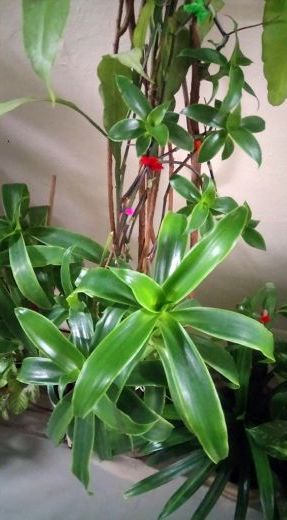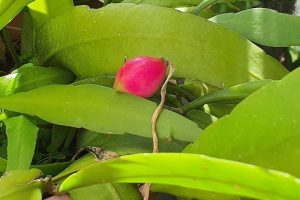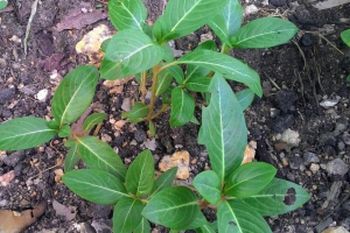Gardening FAQ #9 – What You Need To Know
In this article, we share on how to do 4-bed crop rotation, manage basket plant and how to manage plant fungal disease effectively. Let’s go through the common gardening FAQ, problems and solutions you need when growing your plants indoor and outdoor.
Basket Plant spreads via runners
 I took home this plant which was discarded by someone a few years ago. It was in a very bad state, but I managed to nurse it back to health. I left it along the corridor outside my flat and watered it twice a day. It grew very well and now I have several pots of the plant. However, I have not seen it flower before. What is the name of this plant?
I took home this plant which was discarded by someone a few years ago. It was in a very bad state, but I managed to nurse it back to health. I left it along the corridor outside my flat and watered it twice a day. It grew very well and now I have several pots of the plant. However, I have not seen it flower before. What is the name of this plant?
This plant is botanically known as Callisia fragrans. It has a number of common names such as Basket Plant, Chain Plant and Inch Plant.
It prefers fertile, moist and well-draining soil and should be exposed to filtered sunlight for at least six hours a day. The lack of light will lead to floppy leaves as pictured.
If you want to have control on the sunlight, you can consider using grow lights fixture.
It sends out stolons, which are also called runners – stems produced on the soil surface that sprout a new young plant along the way. The young plants can be cut and potted separately once they are large enough and have produced some roots on their own. To make this shifting easier, you can use grow bags during the initial planting.
The Basket Plant serves as a good candidate to introduce plant propagation via stolons to children and new gardeners.
Palm may be affected by a fungal disease
 I have a few yellow and red palms in my garden. They are at least 20 years old. For the last few years, some have been “dying” slowly – they are rotting from within. The fronds started to decrease in number, the trunks began to shrink and soften and, eventually, the plants would topple over. Now, even the new ones are dying and drying up. But this is happening only to the plants growing in the front of my house. The ones at the back still look healthy. What is the cause of the problem?
I have a few yellow and red palms in my garden. They are at least 20 years old. For the last few years, some have been “dying” slowly – they are rotting from within. The fronds started to decrease in number, the trunks began to shrink and soften and, eventually, the plants would topple over. Now, even the new ones are dying and drying up. But this is happening only to the plants growing in the front of my house. The ones at the back still look healthy. What is the cause of the problem?
Your sealing wax palm (Cyrtostachys renda) may be affected by a fungal disease called the Ganoderma butt rot.
To confirm whether there is an infection, look for fungal fruiting bodies at the base of the clump that resemble the lingzhi fungus. Affected stems will also show an internal discoloration when cut.
There is currently no effective way to manage the disease. As the fungus survives in the soil, planting another palm in the same location is not recommended.
It is best to practice “crop rotation” by planting another unrelated plant species in the affected site.
Check out the video below which talks about a 4-bed crop rotation system. It explains the reasons for rotating your crops. Crop rotation is a way of minimising pests and diseases in your garden by not planting vegetables from the same family in the same soil year after year. It looks at the nutrition needs of crops to make gardening easier and more successful.
Key points from the videos are:
- Split the crops into roots, fruit, leaves and legumes
- Don’t put the same type of plant in the same soil year after year
- Potatoes are great for breaking up new soils
- Legumes (peas and beans) have nitrogen fixing nodules so are good at building up nutrients in the soil
- Add lime and compost to prepare the soil for peas and plant the seeds twice as deep as the seed; up to the 2nd knuckle of your finger
- Follow legumes with a hungry crop like kale and lettuce
- Follow leafy crops with root and fruiting crops
- Carrots and parsnips and good for drawing up nutrients deep in the soil
- When beds are fallow, plant a green manure cover crop
For suggestions on how to control another plant worst enemy, head over to our section on Weed & Moss Control.
Princess Epiphyllum produces pink fruit
 This potted plant outside my flat always produces flowers, but for the first time, I found this red oval that grew after a flower had withered. What is it and what can I do with it?
This potted plant outside my flat always produces flowers, but for the first time, I found this red oval that grew after a flower had withered. What is it and what can I do with it?
The plant is botanically known as Epiphyllum pumilum and goes by its common name, Princess Epiphyllum. Its scented flowers are produced in abundance and remain open during the day. The pink ball, produced at the end of the flattened stem, is its fruit.
You can harvest the fruit and grow new plants from the seeds within, although propagation via stem-cuttings is still a faster method.
Madagascar periwinkle thrives in sunny spot
 What is this weed in my garden? Does it have any medicinal uses?
What is this weed in my garden? Does it have any medicinal uses?
The young plants are probably those of the Madagascar periwinkle. The botanical name of this plant is Catharanthus roseus.
This plant grows best in a sunny spot with well-drained soil. It is an ornamental plant that is grown for its attractive flowers.
There are medicinal uses for the plant, but it is not recommended you self-medicate as the plant is highly toxic.